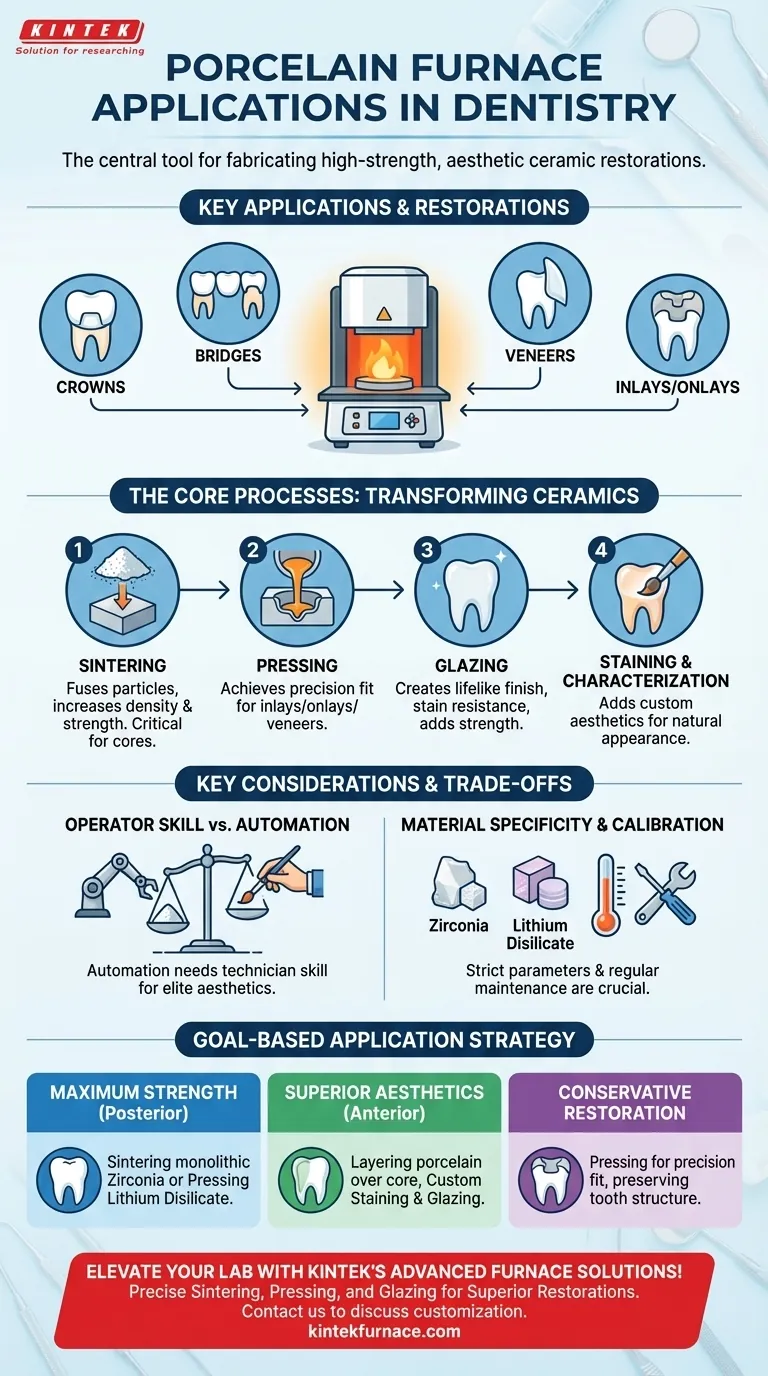In modern dentistry, the porcelain furnace is the central tool for fabricating nearly all high-strength, aesthetic ceramic restorations. Its primary applications are creating custom dental crowns, bridges, veneers, inlays, and onlays by precisely heating and processing advanced ceramic materials to achieve the necessary strength and appearance.
A porcelain furnace does more than just heat material; it fundamentally transforms dental ceramics through controlled processes like sintering and glazing. This transformation is what gives restorations their essential properties of strength, durability, and lifelike aesthetics.
The Core Processes Behind the Applications
A porcelain furnace is not simply an oven. It is a highly precise instrument that executes specific thermal programs to change the physical properties of dental ceramics. Understanding these core processes reveals why it is indispensable.
Sintering: Building Structural Integrity
Sintering is the process of heating compacted ceramic powder to a temperature just below its melting point. This causes the individual particles to fuse, drastically reducing porosity and increasing the material's density and strength.
This function is critical for creating the strong, underlying core of restorations like crowns and multi-unit bridges, which must withstand significant chewing forces.
Pressing: Achieving Precision and Fit
Some furnaces are designed to "press" ceramics. In this technique, a wax model of the restoration is created and encased in an investment material. The furnace then heats a ceramic ingot until it becomes molten and presses it into the mold created by the burned-out wax.
This process is renowned for producing restorations like inlays, onlays, and veneers with exceptionally accurate marginal fit, which is crucial for longevity and preventing future decay.
Glazing: Creating a Lifelike Finish
Glazing involves applying a thin layer of glass-like porcelain to the surface of a sintered or pressed restoration and firing it at a specific temperature.
This final step creates a smooth, non-porous, and lustrous surface that resists staining and mimics the natural sheen of tooth enamel. It also increases the overall strength of the final restoration.
Staining and Characterization: Customizing Aesthetics
Before the final glaze firing, a dental technician can apply specialized colorants or "stains" to the surface of the restoration. The furnace then fires these stains permanently onto the ceramic.
This allows the technician to add subtle characterizations—such as translucency, faint cracks, or color gradients—that make the artificial tooth indistinguishable from the patient's natural teeth.
Understanding Key Considerations and Trade-offs
While essential, the successful use of a porcelain furnace is dependent on several critical factors that represent the trade-offs between automation and artistry.
Operator Skill vs. Automation
The furnace flawlessly automates the heating cycle, but the final quality of a restoration depends heavily on the skill of the dental technician. Achieving elite aesthetics requires an artist's eye for form, color, and characterization during the layering and staining phases.
Material Specificity and Programming
Different dental ceramics, such as zirconia, lithium disilicate, or feldspathic porcelain, have unique and strict firing parameters. Using the wrong program for a specific material will lead to a failed restoration, resulting in cracks, poor fit, or unnatural color.
Calibration and Maintenance
Porcelain furnaces are precision instruments that require regular calibration to ensure temperature accuracy. A deviation of even a few degrees can compromise the physical properties and aesthetic outcome of the ceramic, making consistent maintenance a non-negotiable part of the workflow.
How to Apply This to Your Goal
The furnace's application is chosen based on the clinical objective for the patient.
- If your primary focus is maximum strength for posterior teeth: Sintering a monolithic zirconia crown or pressing a high-strength lithium disilicate crown is the correct application.
- If your primary focus is superior aesthetics for anterior teeth: Layering porcelain over a zirconia core, followed by custom staining and glazing for a veneer or crown, is the ideal approach.
- If your primary focus is conservative restoration and precision fit: Pressing ceramic for inlays and onlays is the most effective use of the furnace to preserve healthy tooth structure.
Ultimately, the porcelain furnace empowers dental professionals to transform raw materials into durable, functional, and beautiful restorations that integrate seamlessly with a patient's natural dentition.
Summary Table:
| Application | Key Process | Benefits |
|---|---|---|
| Crowns & Bridges | Sintering | High strength, withstands chewing forces |
| Veneers, Inlays, Onlays | Pressing | Precision fit, conserves tooth structure |
| All Restorations | Glazing | Lifelike finish, stain resistance, added strength |
| Custom Aesthetics | Staining & Characterization | Natural appearance, matches patient teeth |
Elevate your dental lab's capabilities with KINTEK's advanced high-temperature furnace solutions! Our Muffle, Tube, Rotary, Vacuum & Atmosphere Furnaces, and CVD/PECVD Systems, backed by deep customization, ensure precise sintering, pressing, and glazing for superior crowns, bridges, and veneers. Contact us today to discuss how we can tailor a furnace to meet your unique dental restoration needs and boost efficiency!
Visual Guide

Related Products
- Dental Porcelain Zirconia Sintering Ceramic Vacuum Press Furnace
- Chairside Dental Porcelain Zirconia Sintering Furnace with Transformer for Ceramic Restorations
- High Temperature Muffle Oven Furnace for Laboratory Debinding and Pre Sintering
- 1700℃ High Temperature Laboratory Tube Furnace with Quartz or Alumina Tube
- Vacuum Heat Treat Sintering Furnace with Pressure for Vacuum Sintering
People Also Ask
- What are some common mistakes when operating dental sintering furnaces? Avoid Costly Errors for Perfect Zirconia Restorations
- Why is proper ventilation important in dental sintering furnaces? Ensure Quality and Safety in Your Lab
- What factors should be considered when choosing a dental sintering furnace? Ensure Quality and Efficiency for Your Lab
- What factors determine the quality of sintered zirconia restorations? Master Material, Equipment, and Technique
- What is the purpose of dental sintering furnaces? Transform Zirconia into Durable, High-Quality Dental Restorations



















